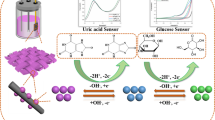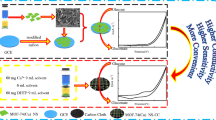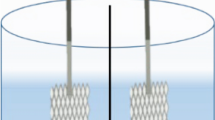Abstract
An electrochemical sensor for detecting ketoprofen was constructed by in-situ grown copper cobaltate (CuCo2O4) nanoneedle arrays on a carbon cloth (CC) substrate. The resulting porous nanoneedle arrays not only expose numerous electrochemically active sites but also significantly enhance the electrochemical apparent active area and current transmission efficiency. By leveraging its electrochemical properties, the sensor achieves an impressive detection limit for ketoprofen of 0.7 pM, with a linear range spanning from 2 pM ~ 2 µM. Furthermore, the sensor exhibits remarkable reproducibility, anti-interference capabilities, and stability. Notably, the developed sensor also performed ketoprofen detection on real samples (including drug formulations and wastewater) and demonstrated excellent recognition ability. These exceptional performances can be attributed to the direct growth of CuCo2O4 nanoneedle arrays on the CC substrate, which facilitates a robust electrical connection, provides abundant electrocatalytic active sites, and expands the apparent active area. Consequently, these improvements contribute to the efficient trace detection capabilities of the ketoprofen sensor.
Graphical Abstract









Similar content being viewed by others
References
Wang J, Zhao SQ, Zhang MY, He BS (2018) Targeted eco-pharmacovigilance for ketoprofen in the environment: need, strategy and challenge. Chemosphere 194:450–462
Tuchiua BM, Stadena RS, Staden JFV (2022) Recent trends in Ibuprofen and Ketoprofen Electrochemical Quantification - A review. Crit Rev Anal Chem 1–12
Gupta A, Bah M (2016) NSAIDs in the treatment of postoperative pain. Curr Pain Headache Rep 20:62
Badri W, Miladi K, Nazari QA, Greige-Gerges H, Fessi H, Elaissari A (2016) Encapsulation of NSAIDs for inflammation management: overview, progress, challenges and prospects. Int J Pharm 515:757–773
Verma1 R, Kumar S, Goyal A, Chaudhary A (2016) Comparison of single dose transdermal patches of diclofenac and ketoprofen for postoperative analgesia in lower limborthopaedic surgery. Int J Res Med Sci 4:718–721
Torrinha A, Martins M, Tavares M, Delerue-Matos C, Morais S (2021) Carbon paper as a promising sensing material: characterization and electroanalysis of ketoprofen in wastewater and fish. Talanta 226:122111
Aguilar-Lira GY, López-Barriguete JE, Hernandez P, Álvarez-Romero GA, Gutiérrez JM (2023) Simultaneous voltammetric determination of non-steroidal anti-inflammatory drugs (NSAIDs) using a modified Carbon Paste Electrode and Chemometrics. Sensors 23:421
Elena F (2015) Pharmaceuticals in the environment: expected and unexpected effects on aquatic fauna. Ann N Y Acad Sci 1340:20–28
Li J, Xu L, Shi ZG, Hu M (2015) A novel two-dimensional liquid chromatographic system for theonline toxicity prediction of pharmaceuticals and related substances. J Hazard Mater 293:15–20
Al-Khateeb LA, Al-zahrani MA, El-Maghrabey M, Dahas FA, El-Shaheny R, El Hamd MA (2021) Extra-thermodynamic study of the retention of anti-inflammatory 2-aryl-propionic acid derivatives on a heat-resistive stationary phase: application of HTLC approach for pharmaceutical and biological analysis. Microchem J 169:106597
Afonso-Olivares C, Fernandez-Rodriguez C, Ojeda-Gonzalez RJ, Sosa-Ferrera Z, Santana-Rodriguez JJ, Dona Rodriguez JM (2016) Estimation of kinetic parameters and UV doses necessary to remove twenty-three pharmaceuticals from pre-treated urban wastewater by UV/H2O2. J Photochem Photobiol A 329:130–138
Cebula Z, Niedzialkowski P, Ossowski T (2018) Electrochemical Behavior and determination of Ketoprofen at Glassy-Carbon Electrode. Appl Biosci 1:7–8
Bogdanowicz R, Niedzialkowski P, Sobaszek M, Burnat D, Bialobrzeska W, Cebula Z, Sezemsky P, Koba M, Stranak V, Ossowski T, Smietana M (2018) Optical Detection of Ketoprofen by its electropolymerization on an Indium Tin Oxide-Coated Optical Fiber Probe. Sensors 18:1361
Pendashteh A, Rahmanifar MS, Kanerc RB, Mousavi MF (2014) Facile synthesis of nanostructured CuCo2O4 as a novel electrode material for high-rate supercapacitors. Chem Commun 50:1972–1975
Zheng JH, Liu XY, Zhang L (2020) Design of porous double-shell Cu2O@CuCo2O4 Z-Scheme hollow microspheres with superior redox property for synergistic photocatalytic degradation of multi-pollutants. Chem Eng J 389:124339
Reddy MV, Yu C, Fan JH, Loh KP, Chowdari BVR (2012) Molten salt synthesis and energy storage studies on CuCo2O4 and CuO·Co3O4. RSC Adv 2:9615–9620
Cui SQ, Gu SQ, Ding YP, Zhang JJ, Zhang Z, Hu ZQ (2017) Hollow mesoporous CuCo2O4 microspheres derived from metal organic framework: a novel functional materials for simultaneous H2O2 biosensing and glucose biofuel cell. Talanta 178:788–795
Das AK, Kim NH, Lee SH, Sohn YK, Lee JH (2018) Facile synthesis of porous CuCo2O4 composite sheets and their supercapacitive performance. Compos Part B 150:234–241
Xiao XC, Zhang ZY, Nan F, Zhao Y, Wang PK, He F, Wang YD (2021) Mesoporous CuCo2O4 rods modified glassy carbon electrode as a novel non-enzymatic amperometric electrochemical sensors with high-sensitive ascorbic acid recognition. J Alloy Compd 850:157045
Yang J, Ye HL, Zhang ZQ, Zhao FQ, Zeng BZ (2017) Metal-organic framework derived hollow polyhedron CuCo2O4 functionalized porous graphene for sensitive glucose sensing. Sens Actuators B 242:728–735
Liu SD, Hui KS, Hui KN (2016) Flower-like copper Cobaltite nanosheets on Graphite Paper as High-Performance Supercapacitor electrodes and Enzymeless glucose sensors. ACS Appl Mater Interfaces 8:3258–3267
Wang Q, Jiang MC, Zhang L (2021) Label-free and visible-light driven photoelectrochemical sensor with CuCo2O4@CoO core-shell hybrid rod as photoanode for selective sensing diclofenac. Electrochim Acta 397:139239
Peng H, Wei GG, Sun KJ, Ma GF, Feng EN, Yang X, Lei ZQ (2018) Integrated and heterostructured cobalt manganese sulfide nanoneedle arrays as advanced electrodes for high-performance supercapacitors. New J Chem 42:18328–18334
Zhang JW, Sun BN, Zhang X, Gao J, Zhang L, Zhao C, Suo H (2023) Simple and ultrasensitive self-supporting electrochemical sensor for Nitrite based on cobalt oxide grafted carbon cloth. Mater Chem Phys 303:127763
Cheng Q, Tang J, Ma J, Zhang H, Shinya N, Qin LC (2011) Polyaniline-coated Electro-Etched Carbon Fiber Cloth electrodes for Supercapacitors. J Phys Chem C 115:23584–23590
Kokulnathan T, Wang TJ, Murugesan T, Anthuvan AJ, Kumar RR, Ahmed F, Arshi N (2023) Structural growth of zinc oxide nanograins on carbon cloth as flexible electrochemical platform for hydroxychloroquine detection. Chemosphere 312:137186
Chen T, Li XW, Qiu CC, Zhu WC, Ma HY, Chen SH (2014) Oliver Meng Electrochemical sensing of glucose by carbon cloth-supported Co3O4/PbO2 core-shell nanorod arrays. Biosens Bioelectron 53:200–206
Zhang Y, Liu ZY, Wang YG, Kuang X, Ma HM, Wei Q (2020) Directly assembled electrochemical sensor by combining self-supported CoN nanoarray platform grown on carbon cloth with molecularly imprinted polymers for the detection of Tylosin. J Hazard Mater 398:122778
Liu C, Wu X (2018) NiCo2S4 nanotube arrays grown on flexible carbon fibers as battery-type electrodes for asymmetric supercapacitors. Mater Res Bull 103:55–62
Liu L, Li YX, Pang YQ, Lan YQ, Zhou LX (2020) Activation of peroxymonosulfate with CuCo2O4@kaolin for the efficient degradation of phenacetin. Chem Eng J 401:126014
Hao C, Guo YN, Xian SL, Zheng WH, Gao HW, Wang XH (2021) Fabrication of flower-shaped CuCo2O4@MgMoO4 nanocomposite for high-performance supercapacitors. J Energy Storage 41:102972
Zhang CH, Sui QL, Lu L, Zou YJ, Xu F, Sun LX, Cai D (2023) Hollow core-shell CuCo2O4@MoNi-layered double hydroxides as an electrode material for supercapacitors. J Energy Storage 61:106691
Vijayakumar S, Nagamuthu S, Ryu KS (2017) CuCo2O4 flowers/Ni-foam architecture as a battery type positive electrode for high performance hybrid supercapacitor applications. Electrochim Acta 238:99–106
Liu DS, Liu YF, Liu XH, Xu CJ, Zhu J, Chen HY (2022) Growth of uniform CuCo2O4 porous nanosheets and nanowires for high-performance hybrid supercapacitors. J Energy Storage 52:105048
Song KF, Ai W, Zhang Y, Zeng YT, Yu YW, Qiao HD, Liu ZY, Shen XD, Hu XH, Hu XL (2021) Three-dimensional self-supported CuCo2O4 nanowires@NiO nanosheets core/shell arrays as an oxygen electrode catalyst for Li-O2 batteries. J Mater Chem A 9:3007–3017
Sun JL, Tian XD, Xu CJ, Chen HY (2021) Porous CuCo2O4 microtubes as a promising battery-type electrode material for high-performance hybrid supercapacitors. J Materiomics 7:1358–1368
Jiang YW, Chai KJ, Wang YQ, Zhang HD, Xu WM, Li WM, Shi YF (2019) Mesoporous silica-supported CuCo2O4 mixed-metal oxides for the aerobic oxidation of alcohols. ACS Appl Nano Mater 2:4435–4442
Sheng S, Ye K, Gao YY, Zhu K, Yan J, Wang GL, Cao DX (2021) Simultaneously boosting hydrogen production and ethanol upgrading using a highly-efficient hollow needle-like copper cobalt sulfide as a bifunctional electrocatalyst. J Colloid Interface Sci 602:325–333
Song HY, Zhao H, Zhang XF, Xu YM, Cheng XL, Gao S, Huo LH (2019) A hollow urchin-like α-MnO2 as an electrochemical sensor for hydrogen peroxide and dopamine with high selectivity and sensitivity. Microchim Acta 168:210
Ghoneim MM, Tawfik A (2003) Voltammetric studies and assay of the anti-inflammatory drug ketoprofen in pharmaceutical formulation and human plasma at a mercury electrode. Can J Chem 81:889–896
Arulraj AD, Devasenathipathy R, Chen SM, Vasantha VS, Wang SF (2016) Femtomolar detection of mercuric ions using polypyrrole, pectin and graphene nanocomposites modified electrode. J Colloid Interface Sci 483:268–274
Zhang L, Li C, Chen Y, Li SB, Li FB, Wu XF, Gui T, Cao Z, Wang YJ (2023) MIL-101(cr) molecular cage anchored on 2D Ti3C2TX MXene nanosheets as high-performance electrochemical sensing platform for detection of xanthine. Microchim Acta 190:268
Zhang L, Li JJ, Zhou RX, Hu SQ, Wang CX, Wang YL, Zhao PC, Xie YX, Fei JJ (2023) Ultrasensitive rutin electrochemical sensor based on in-situ salt template growth two-bimetallic ZIF-derived zinc/cobalt@nitrogen doped ultra-thin carbon nanosheets (Zn/Co@N-CNSs). Electrochim Acta 470:143304
Karimi-Harandi MH, Shabani-Nooshabadi M, Darabi R (2022) Simultaneous determination of citalopram and selegiline using an efficient electrochemical sensor based on ZIF-8 decorated with RGO and g-C3N4 in real samples. Anal Chim Acta 1203:339662
Su CL, Li ZY, Zhang D, Wang ZM, Zhou X, Liao LF, Xiao XL (2020) A highly sensitive sensor based on a computer-designed magnetic molecularly imprinted membrane for the determination of acetaminophen. Biosens Bioelectron 148:111819
Denis M, Richard GC (2008) The influence of Electrode Porosity on Diffusional Cyclic Voltammetry. Electroanalysis 20:2387–2394
Streeter L, Wildgoose GG, Shao LD, Compton RG (2008) Cyclic voltammetry on electrode surfaces covered with porous layers: an analysis of electron transfer kinetics at single-walled carbon nanotube modified electrodes. Sens Actuators B 133:462–466
Guo XM, Zhou H, Fan TX, Zhang D (2015) Electrochemical detection of p-nitrophenol on surface imprinted gold with lamellar-ridge architecture. Sens Actuators B 220:33–39
Kormosh Z, Hunka L, Bazel Y, Matviychuk O (2010) Potentiometric determination of ketoprofen and piroxicam at a new PVC electrode based on ion associates of rhodamine 6G. Mater Sci Eng C 30:997–1002
Acknowledgements
This work was supported by the National Natural Science Foundation of China (21771060 and 61271126), the International Science & Technology Cooperation Program of China (2016YFE0115100), Program for Science and Technology Project of Heilongjiang Province (JQ2021B002), Environmental Protection Department Program of Heilongjiang Province (HST2022DQ006), Basic Research Business Fees of Colleges and Universities in Heilongjiang Province (2022-KYYWF-1059), Reform and Development Fund Project of Local University supported by the Central Government, Heilongjiang Touyan Innovation Team Program.
Author information
Authors and Affiliations
Corresponding authors
Ethics declarations
Ethical approval
This research did not involve human or animal samples.
Conflict of interest
The authors declare that they have no known competing financial interests or personal relationships that could have appeared to influence the work reported in this paper.
Additional information
Publisher’s Note
Springer Nature remains neutral with regard to jurisdictional claims in published maps and institutional affiliations.
Electronic supplementary material
Below is the link to the electronic supplementary material.
Rights and permissions
Springer Nature or its licensor (e.g. a society or other partner) holds exclusive rights to this article under a publishing agreement with the author(s) or other rightsholder(s); author self-archiving of the accepted manuscript version of this article is solely governed by the terms of such publishing agreement and applicable law.
About this article
Cite this article
Liu, Y., Xin, Y., Wang, X. et al. CuCo2O4 nanoneedle arrays growth on carbon cloth as a non-enzymatic electrochemical sensor with low detection limit ketoprofen recognition. Microchim Acta 191, 218 (2024). https://doi.org/10.1007/s00604-024-06299-z
Received:
Accepted:
Published:
DOI: https://doi.org/10.1007/s00604-024-06299-z




